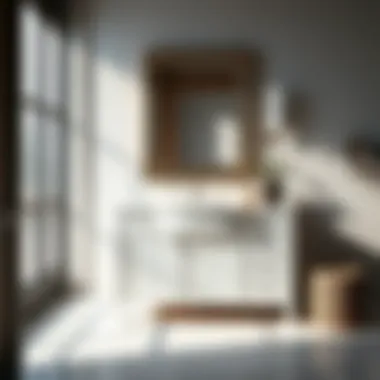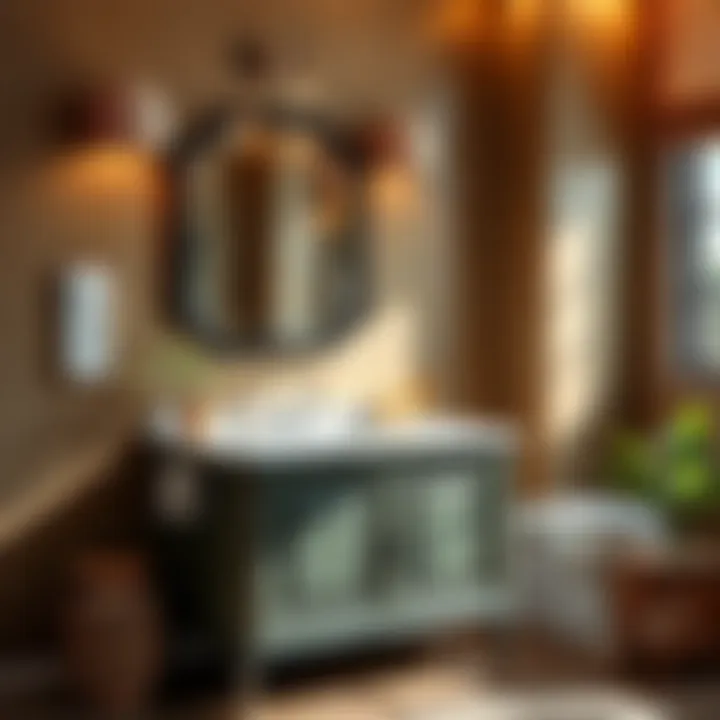Choosing the Perfect 24-Inch Bathroom Vanity Set


Intro
When it comes to bathroom design, the small details can make a world of difference. A 24-inch bathroom vanity set can be the centerpiece of a stylish, functional space. These pieces are more than just storage solutions; they're a reflection of personal tastes and an enhancement to daily routines. As bathrooms morph into personal sanctuaries, understanding the key elements in choosing the right vanity set becomes pivotal.
This article offers a comprehensive exploration of various aspects related to selecting a 24-inch bathroom vanity set. From current trends in design and color palettes to practical tips on maintenance, homeowners will find the essential information all in one place. Whether one leans toward modern minimalism or classic charm, there is something here for everyone.
Current Trends
In the ever-evolving world of interior design, staying abreast of current trends is crucial. The movement toward personalized spaces has meant that 24-inch vanity sets come in various styles, materials, and hues.
Color Palettes
The choice of colors can dramatically influence the ambiance of a bathroom. Some contemporary favorites include:
- Soft Neutrals: Colors like beige and taupe are timeless and create a calming environment.
- Bold Accents: Darker shades, like navy blue or forest green, add sophistication .
- Pastels: Gentle hues such as mint green or baby pink are on the rise, offering a fresh, airy feel.
Selecting the right color palette can tie together various elements in the bathroom, be it tiles, decor, or fixtures.
Popular Styles
Today, homeowners are embracing styles that resonate with their personal aesthetics. Here are some compelling choices:
- Modern Farmhouse: Characterized by rustic wood finishes and vintage metals, this style is cozy yet chic.
- Mid-Century Modern: Look for clean lines and organic shapes, combining functionality with retro flair.
- Transitional: A blend of traditional and contemporary elements, this style suits a broad spectrum of tastes without overwhelming a space.
Incorporating one of these popular styles can greatly enhance the visual appeal of your bathroom, making it both inviting and functional.
"The right bathroom vanity can transform a space from merely functional to entirely transformative."
Visual Ideas
In addition to understanding current trends, taking inspiration from visuals can spark creativity. Here are some notable elements to consider:
- Gallery of Styled Bathrooms: Browse platforms like Pinterest or home decor blogs to see various styling ideas tailored for small spaces.
- Before-and-After Transformations: Focusing on renovations can provide insight into how a simple vanity change can upgrade not only functionality but the overall look.
The potential for a well-chosen 24-inch bathroom vanity set extends beyond aesthetics; it's a step towards creating a space that caters to individual needs while reflecting personal style. This growing trend of personal retreat spaces signifies the importance of thoughtful selections in bathroom vanities, urging homeowners to invest time into understanding their choices.
For a deeper dive into design ideas and tips, take a look at resources like Wikipedia for general design principles, or explore community discussions on Reddit where homeowners share their experiences.
In the next sections, we will delve further into functionality, materials, and maintenance tips to ensure your selected vanity set not only looks great but also serves its purpose effectively.
Prelims to Bathroom Vanity Sets
Bathroom vanity sets are more than just functional pieces of furniture; they serve as the centerpiece in many bathrooms, reflecting both style and practicality. Choosing the right vanity can significantly impact the aesthetic and operational qualities of your space. When considering a 24-inch bathroom vanity set, it becomes crucial to grasp the distinctive elements that accompany its selection.
Defining Bathroom Vanity Sets
A bathroom vanity set typically comprises a cabinet, sink, and countertop, and may also include mirrors and faucets. These fixtures vary in size, style, and material, catering to a range of tastes and needs. For example, a standard 24-inch vanity set can provide ample storage without overwhelming smaller spaces. This compact size often works wonders in apartments or modest homes, where maximizing every inch matters. Think about how a well-chosen vanity can anchor the bathroom design, offering both function and flair.
Importance of Size in Vanity Selection
Size isn’t just a number when it comes to selecting a vanity. The dimensions of your chosen piece directly influence the bathroom’s flow and usability. Especially in tighter spaces, a 24-inch vanity competes against bulky alternatives, proving that small can be mighty. Here are some aspects to consider:
- Functionality: A 24-inch vanity allows for enough surface area to accommodate everyday essentials such as soap and toiletries.
- Visual Balance: Choosing a properly sized vanity will help maintain visual harmony in the layout. An overcrowded bathroom can feel claustrophobic, while a too-large vanity could cheat other necessary elements like floor space or door swings.
- Storage Considerations: With creatively designed 24-inch vanities, you can enjoy multiple storage solutions, whether it be drawers, shelves, or cabinets, tailor-fitted to your daily needs.
In summary: size matters significantly in achieving a balance between utility and design in your bathroom. Knowing the exact measurements and how they fit into your space is the first step in making an informed purchase.
In essence, understanding the foundations of bathroom vanity sets—particularly for the practical 24-inch models—sets the stage for deeper exploration into design styles, functional features, and choosing the right materials. As you navigate through this guide, you'll find insights catered to homeowners looking to elevate their bathroom experience.
Dimensions and Spatial Considerations
Understanding the dimensions and spatial considerations of a 24-inch bathroom vanity set is critical for making informed decisions that ultimately enhance the functionality and aesthetic appeal of the bathroom. Having a vanity that fits well within the existing layout ensures it not only serves its purpose effectively but also complements the overall design of the space.
Understanding 24-Inch Dimensions
When discussing a 24-inch vanity, size is a crucial factor. Unlike larger vanities, a 24-inch option fits snugly into compact bathrooms or half-baths, making it an ideal choice for smaller spaces. A 24-inch design means that the width is exactly two feet, a distance that offers enough surface area for everyday use, while keeping the room open and airy. This dimension strikes a balance between practicality and space efficiency, important when you don’t want your surroundings to feel cramped.
It’s vital to recognize that even within the confines of a 24-inch measurement, design variations can occur. The depth and height can differ across various models. So, taking precise measurements of the specific model before making a purchase could save homeowners from potential headaches during installation.
Assessing Your Bathroom Layout
When it comes to installing a 24-inch vanity, assessing the layout of your bathroom should take center stage in your consideration process. Without a thorough evaluation, you might find yourself stuck in a bind, grappling with size mismatches or awkward placements.
Measuring Available Space
Measuring available space essentially lays the groundwork for a successful installation. This doesn’t just mean grabbing a tape measure and jotting down numbers; it requires an understanding of your existing layout. Given the vanity’s dimensions, ensuring adequate clearance around it is critical for daily usage. This is beneficial for avoiding unexpected inconveniences, like bumping into other fixtures or doors.


Moreover, the characteristic of accurately measuring available space allows homeowners to visualize how the vanity fits in with elements like the toilet, shower, and other bathroom features. Utilizing laser measuring tools or even app-based measuring devices can help in achieving precise dimensions quickly.
On the downside, if measurements are taken hastily, it can lead to errors that are costly, both financially and in terms of time. Thus, the importance of this step cannot be overstated.
Considerations for Door and Fixture Placement
The placement of doors and fixtures forms a pivotal component of any bathroom design. Think about it: a beautifully designed vanity won’t deliver its full potential if it's awkwardly situated in relation to functional elements like the bathroom door or the shower. Careful consideration of both these aspects shapes how the space is experienced by everyone who uses it.
One key characteristic of adequate door placement is facilitating proper access to and from the vanity. Placing a vanity too close to the door can result in an uncomfortable flow or make it hard to open cabinets fully. This is a common oversight that homeowners often overlook during planning.
Interestingly enough, factor fixtures into this mix. Their proximity to the vanity can create a seamless experience, but it's important to ensure they don't crowd the space.
While these considerations may not seem earth-shattering, they play a significant role in user experience. Neglecting these factors can lead to mishaps, such as accidentally hitting the vanity with the door when entering or exiting. Ultimately, a well-thought-out layout maximizes both style and function.
In summary, understanding dimensions and spatial considerations is a multi-layered endeavor. By measuring space methodically and thinking critically about the layout, homeowners set themselves up for success in both installation and daily use of their 24-inch bathroom vanity set.
Design Styles for 24-Inch Vanities
Design styles play a crucial role in shaping the aesthetic and functional appeal of a 24-inch bathroom vanity set. These styles reflect personal tastes while also addressing practical needs regarding space optimization. Understanding the variety of design styles available enables homeowners to select a vanity that not only enhances their bathroom decor but also meets their specific functionality desires. From modern minimalism to traditional intricacies, each style comes with its unique elements that can redefine the space, ensuring it aligns with both usability and beauty.
Modern Aesthetics
Sleek Lines and Minimalism
One key element of modern aesthetics is sleek lines and minimalism. This design approach emphasizes simplicity, often combining understated elegance with sophisticated functionality. The key characteristic of this style is its clean, uncluttered look, which contributes greatly to an open and airy bathroom ambiance. A major advantage of choosing sleek lines is that it makes the space look larger and more organized—ideal for smaller bathrooms.
However, while this style is popular, it may not accommodate those who appreciate elaborate detailing. Minimalist designs typically shy away from excessive ornamentation, favoring geometric shapes instead.
Using Color and Texture
The integration of color and texture is another pivotal aspect of modern vanities. This style allows homeowners to experiment with diverse hues and tactile finishes, providing a canvas for personal expression. A striking key characteristic of this approach is the blend of bold color choices with contrasting textures, which can add depth and interest to the overall design. For instance, pairing a vibrant countertop with a smooth cabinet surface creates a lively yet cohesive look.
This versatility is a significant benefit, allowing for complete customization according to personal preference or current bathroom trends. However, it’s important to maintain a balanced approach; too many competing elements can lead to a chaotic appearance rather than a serene escape.
Traditional Designs
Classic Materials and Finishes
Traditional motifs often feature classic materials and finishes that resonate with timeless appeal. Woods like oak and cherry, typically lacquered or stained, give a luxurious feel that stands up against the test of time. A notable characteristic of classic designs is their warmth and familiarity, making them a comfortable choice for many homeowners.
Choosing these materials can be a wise investment, as they not only elevate aesthetic value but also enhance durability. However, the traditional style might require more maintenance to preserve its original charm compared to modern, lower-maintenance alternatives.
Ornate Details and Fixtures
The allure of ornate details and fixtures in traditional designs adds a layer of sophistication that is hard to replicate. These intricate designs can include carved woodwork or elaborate metal hardware, turning a simple vanity into a statement piece. The key characteristic of this style is its focus on craftsmanship, showcasing the artistry involved in its creation.
While these features can undoubtedly enhance a bathroom’s overall character, they often come with a higher price tag and entailing maintenance requirements, managing dust and the wear that can arise with time.
Transitional Compositions
Transitional designs effectively blend modern and traditional elements, creating a balance between sleek sophistication and classic warmth. This style showcases the practicality of modern aesthetics while incorporating the timeless elegance of traditional designs. Key features include varied materials and finishes combined thoughtfully, offering both functionality and visual intrigue, making it a popular choice for homeowners who desire versatility in their bathroom’s appearance.
In summary, the design style of a 24-inch vanity is not just about looks. It intertwines aesthetics with personal expression and practicality in a manner that can dramatically influence the overall bathroom experience.
Material Choices for Vanity Construction
When selecting a 24-inch bathroom vanity, one cannot overlook the importance of material choices in the construction. The materials not only influence the aesthetic appeal but also determine the functionality and longevity of the vanity. Understanding the differences between various materials helps homeowners choose the best options that fit their style and practical needs.
Choosing the right material can make a significant impact on the overall efficiency of the space. It’s not just about looks; it’s also about durability, maintenance, and how well the material withstands moisture, which is a common enemy in bathrooms. Moreover, the type of material chosen can blend seamlessly or stand out as a statement piece, contributing to the unique character of your bathroom.
Wood Options and Their Characteristics
Wood has been a classic material that lends warmth and elegance to any bathroom. But not all woods are created equal, and their characteristics vary significantly.
Solid Wood vs. Engineered Wood
Solid wood offers the advantage of authenticity. It is made from real trees, which means each piece carries unique patterns and grains, giving an organic feel that’s hard to replicate. However, the upscale nature of solid wood often comes with a higher price tag. On the downside, solid wood may expand or contract with moisture, requiring some upkeep to maintain its beauty.
Engineered wood, on the other hand, is a more budget-friendly alternative. It’s manufactured by combining layers of wood, which makes it less susceptible to humidity-related issues. This can be a beneficial option for homeowners looking for stability and less maintenance. However, engineered wood might not exude the same charm as its solid counterpart, and in some cases, it may not last as long.
Pros and Cons of Each Type
- Solid Wood
- Engineered Wood
- Pros: Durable, unique aesthetics, can be refinished, adds value to the home.
- Cons: Higher cost, potential for warping if not treated properly.
- Pros: Affordable, resistant to moisture, often holds up better in humid conditions.
- Cons: Limited refinishing options, can lack the luxurious feel of solid wood.


Alternative Materials
As home design evolves, so do the materials used to construct vanities. Alternative materials populate the market for good reasons.
Metal Components
Metal components are becoming a trendy choice for those looking to achieve a modern or industrial feel in their bathrooms. Metals like stainless steel or brass not only offer durability but also an edgy aesthetic that stands out. Additionally, they are resistant to moisture and easy to clean, making them practical for bathroom environments. However, some homeowners might find that metal can become cold to the touch and may not suit a cozy, warm design.
Composite Wood Considerations
Composite wood is another alternative that provides a synthesized approach to vanity construction. Made from wood fibers and resin, it’s designed to withstand the unique challenges of bathroom conditions. One of its key characteristics is affordability; composite wood offers a wallet-friendly solution without sacrificing visual appeal. It is resistant to warping, making it suitable for areas with high humidity. However, it might not have the same rich texture or prestige as solid wood options, and can sometimes lack longevity compared to their solid counterparts.
In sum, when selecting materials for a 24-inch bathroom vanity, individuals should weigh the aesthetic desires against the practical needs for moisture resistance and durability. Whether leaning towards the elegance of solid wood or the modern flair of metal components, knowing the options available is key to making an informed choice.
Functional Features of a 24-Inch Vanity
When selecting a 24-inch bathroom vanity, understanding its functional features is pivotal to ensure it serves your needs. A bathroom vanity isn't merely about aesthetics; it combines utility, design, and practicality to create an environment that feels both welcoming and efficient. From storage solutions to integrated sinks, these elements enhance your bathroom experience in myriad ways.
Storage Solutions
Cabinet Designs and Internal Organization
The choice of cabinet design plays a significant role in internal organization, contributing largely to the overall functionality of the vanity. Cabinet designs can range from open shelving to enclosed cabinets with doors, each offering unique advantages.
One of the most popular characteristics of modern cabinets is modularity. These setups allow Customization, so you can add or remove compartments according to your specific needs. A well-organized cabinet can help you easily assign spots for toiletries, cleaning supplies, and other bathroom essentials, making them readily accessible.
A unique feature here is drawer dividers, which help in segmenting various items. This can drastically reduce the chaos of rummaging through a cluttered cabinet, offering an orderly appearance and making it easier to find what you need on a hectic morning. However, one downside with traditional cabinetry might be its tendency to consume wall space, possibly limiting other design features you might want to include in a snug bathroom layout.
Drawer Systems and Pull-Out Options
When it comes to storage, drawer systems are often the unsung heroes of bathroom vanities. They provide a deeper, more organized space that suits everyday cabinetry needs. A key characteristic here is the ability to customize drawer heights and widths, which is ideal for storing items of various shapes and sizes. Drawer systems with pull-out options have become increasingly popular for their practicality.
Pull-out drawers maximize accessibility, allowing more efficient use of space. Being able to pull out a full drawer makes it easy to spot what you’re looking for. On the downside, they might require more frequent adjustments than traditional drawers, especially if they’re loaded heavily.
Integrated Sinks and Countertops
Material Choice for Countertops
Choosing material for countertops can arguably make or break the functionality of your vanity. A significant aspect to consider is durability. Frequently used materials like quartz and granite offer resilience against daily wear, keeping the surface intact for years. These materials are popular because they resist stains and scratches, thereby preserving their visual appeal over time.
A unique feature to note about quartz countertops is their non-porous surface, which prevents bacteria buildup and simplifies cleaning. Although they tend to be on the pricier side, investing in such materials could save you a lot of hassle in the long run. However, one must be cautious as some materials may crack under heavy impact, requiring careful handling.
Sink Types and Their Impact on Space
The type of sink you select can significantly impact how the space feels and operates. For instance, a vessel sink can create a striking focal point, adding height and style to your design. On the other hand, under-mount sinks often save counter space and make for easier cleaning, as they don't interfere with the countertop edges.
The unique feature of integrated sinks is that they provide a seamless look, reducing the presence of gaps that can harbor grime. However, integrated options might be less versatile in the long run, limiting you if you decide to switch out the countertop material later.
"The cabinetry, sink, and countertop in your bathroom vanity are more than just functional elements; they reflect your personal style and enhance daily routines."
Installation Considerations
When it comes to setting up a bathroom vanity, understanding installation considerations is paramount. A 24-inch bathroom vanity set has unique dimensions that require careful planning and execution. The right installation ensures that the unit operates efficiently while maintaining its visual appeal. Missteps during this phase can lead to issues ranging from inadequate spacing for plumbing to unsightly gaps between the wall and the vanity.
Pre-Installation Preparation
Tools Required
Before diving into the installation of your new bathroom vanity, gathering the necessary tools is crucial. A drill, level, wrench, and tape measure can make all the difference in ensuring a smooth install.
Having a level on hand is particularly beneficial; it guarantees that your vanity sits straight, which can help avoid complications down the line, like water pooling or the cabinet leaning. A tape measure is essential for checking the dimensions of your space and confirming that everything fits as intended. While a regular screwdriver will suffice, a power drill can speed up the entire process, making it easier to secure the unit without causing too much wear on your wrist.
Moreover, an adjustable wrench is handy for tightening plumbing connections. These tools all have their unique features that facilitate a seamless installation experience.
Removing Existing Vanities
Prior to placing a new vanity, stripping away the old one is necessary. This process can sometimes feel daunting, but it is pivotal for maximizing the new unit’s fit and function. Removing an existing vanity often involves unscrewing it from the wall and disconnecting plumbing fixtures. It’s crucial to handle this step carefully to avoid damaging plumbing, flooring, or walls.
In terms of advantages, taking down the old unit allows for a clean slate, giving you an opportunity to inspect and possibly upgrade plumbing lines. A downside, however, may be unexpected difficulties with removing stuck fasteners or old adhesive that can slow your progress. Thus, patience and careful handling of tools are vital during this stage.
Step-by-Step Installation Process
Aligning and Securing the Vanity
Once the old vanity is out, it’s time to position the new one. Aligning and securing the vanity correctly is essential to ensure its stability and functionality. This involves placing the unit against the wall in the desired location and making sure it’s level. Many homeowners opt for securing the vanity to the wall at this stage, which helps prevent any future tipping or sliding, especially in smaller bathrooms where space can be tight.
Using a level at this point is again crucial. The result is a clean and professional look. Once secured, it not only gives a strong hold on the unit but also offers peace of mind knowing it won’t budge with the constant use. Consideration should be given to some minor adjustments if the wall is not perfectly straight, which is common in older homes.


Connecting Plumbing Fixtures
Lastly, connecting plumbing fixtures is where everything comes together. This step involves the installation of the sink and the plumbing lines that will facilitate water flow. It’s often tempting to overlook this aspect, but improper connections might lead to leaks — a situation nobody wants to deal with. Many homeowners find it helpful to consult the plumbing guide that accompanies the vanity or seek additional resources where plumbing installation is discussed.
The unique feature of this process is that it can be done entirely from beneath the sink, alleviating the need for awkward positions or reaching into tight spaces. Once everything is connected and turned on, checking for leaks is crucial. Taking time to ensure everything is properly sealed can save a headache later.
“A well-installed vanity doesn’t just look good; it functions effectively and enhances the overall bathroom experience.”
Maintenance and Care for Longevity
Taking good care of your bathroom vanity set isn’t merely a chore; it’s an approach towards ensuring its durability and maintaining the beauty of your space for years to come. A bathroom is often a sanctuary, a place to relax, and thus, the aesthetics of that sanctuary should be preserved. Regular maintenance can help prevent costly repairs down the line, and a little effort can extend the life of your vanity significantly.
Cleaning Techniques for Different Materials
Different materials used in vanity construction come with their own set of cleaning needs. Knowing how to properly clean and maintain your vanity helps in keeping it in tip-top shape.
- Wooden Vanities: Use a soft cloth and a gentle wood cleaner. Avoid excessive water as it can warp the wood. Wipe spills immediately to prevent stains.
- Laminate Vanities: A mild detergent mixed with water works best. Swab with a non-abrasive sponge to avoid scratches.
- Stone Countertops: Employ a pH-balanced cleaner and refrain from acidic or abrasive cleaners. Regular sealing is recommended to prevent stains and etching.
- Metal Fixtures: A damp cloth with mild soap can do wonders, but harsh cleaners may dull the finish. Rinse and dry to keep them shining bright.
Each type of material deserves special attention to optimize its lifespan, and knowing these techniques can assist you in making the right choices.
Avoiding Common Damages
Protecting your bathroom vanity from wear and tear guarantees that it stays a vibrant part of your home. Let’s dive into two significant aspects: managing moisture and humidity as well as handling everyday wear.
Managing Moisture and Humidity
The bathroom is a natural hotspot for moisture and humidity, which can lead to unsightly mold or deterioration if not managed. Ensuring proper ventilation is key. Installing an exhaust fan can significantly reduce humidity levels, aiding in the longevity of your vanity. Additionally, you might want to consider using a dehumidifier during humid months.
Remember: Maintaining a humidity level below 60% is ideal for protecting your wooden furniture from warping and ensuring longevity.
This aspect is crucial in preventing structural damages and can save you from financial setbacks.
Handling Everyday Wear
The vanity bears the brunt of daily life, from splashes during brushing teeth to wear from cosmetic products. A few simple strategies can keep it looking new. Consider placing coasters under cosmetic items or utilizing trays to organize products instead of directly placing them on the surface. Furthermore, taking the time to regularly wipe down the surfaces can prevent build-up of grime.
One of the unique characteristics of managing wear is that it encourages a mindful approach to how you treat your space. A little diligence can prevent minor issues from escalating into expensive fixes down the road.
In wrapping up, proper maintenance and care help in maintaining the vanity's function and form, ensuring its presence in your home reflects the style and serenity you cherish.
Budgeting for a Bathroom Vanity Set
Setting a budget for a bathroom vanity set is a pivotal step in creating that sanctuary you envision for your home. It’s not just about picking a pretty piece to hang on the wall. A vanity set speaks volumes about your style while offering functionality and storage. Knowing where to place your financial bets can save you time, heartache, and potentially a few dollars down the line.
When asking what your budget should be, it’s essential to consider the elements involved. From the basic structure and materials to the aesthetic flair and features, the costs can pile up faster than ya can say “subpar renovation.” It’s also wise to remember that investing in quality often translates to longevity; a little more spent now can bring savings in repairs later.
Price Ranges for Different Styles and Materials
When browsing for that oddly perfect 24-inch vanity, it helps to know what one might expect to pay. Prices can swing widely based on design and materials. Here’s a rough guide:
- Basic Models: $200 - $400
Often made from composite materials, these offer functionality without breaking the bank. Ideal for those seeking simplicity in design. - Mid-Range Options: $400 - $800
Here, you’ll start to see better craftsmanship, often in solid wood or higher-grade composites. These come with various design styles, allowing for more personal expression. - Luxury Choices: $800 - $2,000
Think about custom-made units or those made from high-end materials like natural stone or metal. They come with exquisite detailing and innovative features, such as integrated sinks or specialized finishes.
It’s not all about price, however; shopping smart is key. Consider clearance sales or gently used vanities that have personality without the hefty price tag and check local listings online or social media marketplace pages.
Evaluating Quality Against Cost
It’s a balancing act, really. Spending a small fortune on a low-quality piece isn’t advisable. This is where doing a little homework pays dividends. Before you opt for a vanity that makes your heart sing, inspect the quality carefully.
- Materials: Solid wood generally holds up better over the years compared to pressboard. Look for terms like “plywood” or “hardwood”; these are your pals.
- Construction: Check how the pieces are joined. Dovetail joints are strong, while staples are stronger than, say, glue but not as durable as you might want.
- Finishes: Preference for surface treatments can guide your choice. A robust finish resists moisture better and keeps wear at bay.
To wrap up, spend some time scoping out different stores or websites. Those hours will lead you to hidden gems and is worth every penny. So research, measure twice, and budget once—your bathroom will thank you for it.
"The bitterness of poor quality remains long after the sweetness of low price is forgotten."
For extra insights, check resources like Wikipedia, which covers the historical aspect of vanities, or Reddit for real-life experiences and tips.
Closure
In wrapping up our exploration of the 24-inch bathroom vanity set, it's essential to consider the significant influence this piece has on the overall bathroom experience. A well-chosen vanity must not only serve its primary functions of storage and aesthetics, but also harmonize with the unique dimensions and design style of your space. First and foremost, the size allows for optimization in smaller bathrooms, where every inch counts. It's a delicate balance of function and form that can enhance your daily routine while reflecting your personal taste.
Ensuring that you’ve considered elements like materials, installation complexity, and budget when selecting a vanity will pay dividends in satisfaction. A bathroom isn't merely a functional area; it's a sanctuary that warrants care and thought. By delving deeply into design choices, materials, and installations, homeowners can create a harmonious setting that isn’t just visually appealing but also maximizes usability and longevity.
Recapping Key Points
- Understanding Size: A 24-inch vanity is ideal for smaller spaces, providing necessary functionality without overwhelming the room.
- Design Styles: From modern to transitional designs, the aesthetic of your vanity can set the tone for your entire bathroom.
- Material Choices: Selecting the right materials influences not only the vanity's look but also its maintenance and durability.
- Installation Process: Preparing adequately for installation helps avoid common pitfalls, ensuring a smooth setup.
- Budget Considerations: Quality versus cost is paramount; striking a balance can determine the vanity's impact on your home's value.
Final Recommendations
When it comes to selecting a 24-inch vanity, practicality and style should guide your choices. Always prioritize materials that endure the moist bathroom environment, while ensuring that the style aligns with your home’s decor. If you find yourself unsure, consult with professionals or browse online forums like Reddit, where home improvement enthusiasts share practical experiences and insights.
Think about keeping a close watch on sales or seasonal promotions, as selecting the right timing can influence budget flexibility. Finally, remember that a bathroom renovation is not just about the vanity itself; it’s about curating an entire ambiance that rejuvenates your senses daily.
As you embark on this journey, take measured steps and enjoy each decision, because building your personal retreat doesn't have to be rushed. The right vanity will not only elevate your space but will also harmonize beautifully with your lifestyle.



